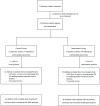Feasibility and Effectiveness of a Wearable Technology-Based Physical Activity Intervention in Preschoolers: A Pilot Study
- PMID: 30142911
- PMCID: PMC6163401
- DOI: 10.3390/ijerph15091821
Feasibility and Effectiveness of a Wearable Technology-Based Physical Activity Intervention in Preschoolers: A Pilot Study
Abstract
The purpose of this pilot study was to evaluate the feasibility and the effectiveness of an intervention that employed a technology-based physical activity (PA) monitoring system and teacher-regulated strategies to promote PA in preschoolers. A total of 93 preschoolers (53% girls, 4.7 years) from 5 child care centers were recruited for a one-week intervention and randomly assigned into control (2 centers, n = 45) or intervention (3 centers, n = 48) group. Key intervention components included: (1) wearable device-based, real-time monitoring of children's PA by classroom teachers and (2) teacher-regulated strategies for providing more opportunities for PA. Sedentary behavior (SED) and PA were measured using accelerometers. Overall, children in the intervention group showed significantly lower level of SED (31.6 vs. 33.6 min/h) and higher level of total PA (28.4 vs. 26.4 min/h) than children in the control group, after adjusting for age, sex, race, parent education level, parent perception of their child's PA, BMI, and childcare centers. Teachers in the intervention group reported that the intervention was highly feasible to be implemented in their current classroom settings. In conclusion, we observed high acceptability and initial effectiveness of the current intervention. Subsequent research at larger-scale is warranted to fully evaluate the effectiveness of the intervention strategies tested in this study.
Keywords: intervention; physical activity; preschool; sedentary behavior; social ecological model.
Conflict of interest statement
The authors declare no conflict of interest.
Figures


References
-
- Leppanen M.H., Nystrom C.D., Henriksson P., Pomeroy J., Ruiz J.R., Ortega F.B., Cadenas-Sanchez C., Lof M. Physical activity intensity, sedentary behavior, body composition and physical fitness in 4-year-old children: Results from the ministop trial. Int. J. Obes. (Lond.) 2016;40:1126–1233. doi: 10.1038/ijo.2016.54. - DOI - PubMed
-
- Pate R.R., O’Neill J.R., Liese A.D., Janz K.F., Granberg E.M., Colabianchi N., Harsha D.W., Condrasky M.M., O’Neil P.M., Lau E.Y., et al. Factors associated with development of excessive fatness in children and adolescents: A review of prospective studies. Obes. Rev. 2013;14:645–658. doi: 10.1111/obr.12035. - DOI - PubMed
-
- Leppanen M.H., Henriksson P., Delisle Nystrom C., Henriksson H., Ortega F.B., Pomeroy J., Ruiz J.R., Cadenas-Sanchez C., Lof M. Longitudinal Physical Activity, Body Composition and Physical Fitness in Preschoolers. Med. Sci. Sports Exerc. 2017;49:2078–2085. doi: 10.1249/MSS.0000000000001313. - DOI - PubMed
-
- National Center for Education Statistics . Digest of Education Statistics, Preschool and Kindergarten Enrollment. Institute of Education Sciences; Washington, DC, USA: 2016.
MeSH terms
LinkOut - more resources
Full Text Sources
Other Literature Sources
Medical

